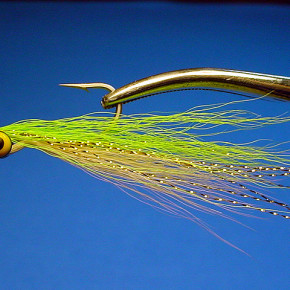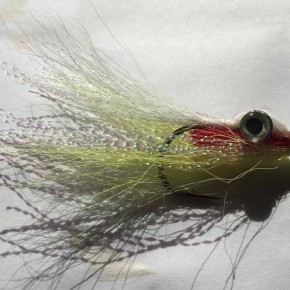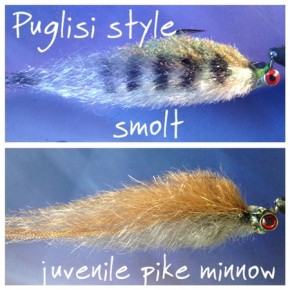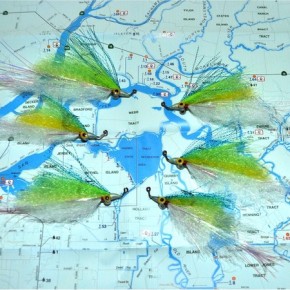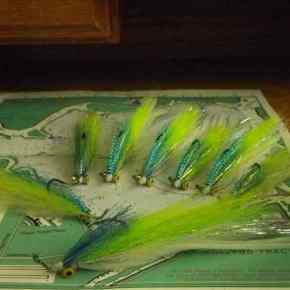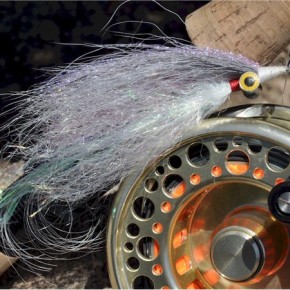Many factors come to play when designing the perfect fly for a destination, the most obvious being what the endemic baitfish look like and what are the fish keying in on. In designing a fly for San Luis, the obvious bait fish to copy is the two to three inch long delta or wakasagi smelt. There are actually several species of Smelt found in San Luis — H. nipponensis (Wakasagi Smelt) and H. transpacificus (the Delta Smelt). Ironically, the Wakasagi Smelt was introduced into the California watershed from Tokyo in 1959 by the California Fish and Game to increase food supplies for Rainbow trout in inland lakes after unsuccessfully trying to introduce native smelt species like the Delta Smelt. Wakasagi has been verified as spawning in San Luis reservoir and the Forebay, but the true delta smelt, transpacificus, may need more salinity in order to spawn and has not been confirmed in the the Forebay and Lake in quantity.. The Wakasagi smelt and the Delta Smelt look nearly identical, and many of the studies done on Delta Smelt may have not differentiated between the two genetically different species. The Wakasagi smelt swims faster and is more saline tolerant than the Delta Smelt.
- Delta Smelt
- Wakasagi Smelt
The second species of baitfish that I have encountered in the stomachs of San Luis Stripers is threadfin shad. Threadfin Shad are more silver and have a different silhouette than delta smelt. Also a Nonindigenous Aquatic Species, the threadfin shad spawn in the lake. Shad migrations take place when the water starts getting near 68 degrees which is ideal spawning temperature, They spawn in the shallow water coves usually in late April into July. I have caught more stripers with threadfin in them in the big lake but I also find them occasionally forebay fish. Smaller cousins of the American Shad which are also found in the lake and forebay and grow up to 6 lbs. They migrate around the lake and forebay in schools followed by hungry stripers. One year I actually came across a 20 lb striper half alive with a three pound shad stuck in its throat head first. I captured the fish and tried to rescue it but the shads dorsal fins were stuck tight. Stripers eat baitfish head first and sometimes stun them before positioning them for swallowing. 
In addition to these two major baitfish, I have found crayfish, American Shad, midges, and freshwater shrimp as well as cut anchovies, sardines and ocean shrimp inside San Luis and Forebay stripers over the years. Despite the buffet of food in the water, San Luis Stripers tend to be opportunistic feeders eating any meaty thing that is easy. My go to flies for stripers in the Lake and Forebay have always been baitfish imitations. I think that Stripers eat every day mainly during the light transition periods and are opportunistic feeders. A 50 lb ocean striper eats ten pounds of food a day to thrive . The landocked stripers in the lake have similar behaviors to those found in the ocean and delta. In the absence of tides, Stripers and forage fish seek out current. The main currents in the lake are created by the trash rack pumps and the wind and several outlets. In the Forebay there is 4 sources of current- the Lake pumps, the Mendoza canal inlet and outlet, and the O’Neill Pumping-Generating Plant. The popular adage, “Find the bait and you’ll find the Stripers,” is certainly true at San Luis Reservoir and the ONeill Forebay.
I have seen stripers breaking on schools of bait and I know that the probability of catching stripers goes up once you find roaming bait, but it is my guess from observation and experience that SL stripers like structure. many of the really big fly caught fish were caught casting right at structure –rocks along the dam, cement pilings, underwater ledges, dropoffs and rock piles, pipes and pumping areas. Stripers are by nature, designed to blend in with structure, thus the black and white stripes. Stripers on the east coast are nicknamed ‘rockfish”.
Stripers have very sensitive lateral lines. World class striper fishing like Greg Myerson, target large stripers with sounds. He fishes rattles tuned to the frequency of lobsters to consistently catch monster stripers. Greg fishes for stripers during the quietest times in the ocean, slack tide. He believes large stripers are lazy opportunistic feeders and that they find it easier to key in on sound during quiet times in the ocean namely slack tides. He also fishes the quarter moon which is the longest feeding window available during the moon phases. Myerson caught 3 of his world record stripers on the first quarter moon of the month at sunset during slack tides. With the slow moving currents, the low amount of noise, and a bright moon above they find it much easier to hear and zero in on sound targets and go for the easiest to locate meal vs chasing bait fish around. In San Luis reservoir, rattled flies fished slowly on the bottom and around structure is very effective when the light is changing.
Stripers don’t have sharp teeth to cut baitfish into smaller pieces before they eat them. They are crushers and have mouths like sandpaper. Stripers will stun a three inch baitfish and then eat it head first. Many times have I stripped a fly and had a short hit while the fly was in motion followed by a hard hit at the pause. I believe that shorter hooks out fish longer shank hooks at SL because stripers key in on the eye of the baitfish to position it head first before swallowing it since they are unable to cut the fish with there teeth. The baitfish tends to be smaller in San Luis reservoir and O Neill Forebay than in the delta and thus the effective fly sizes are also smaller. The size discrepancy may be because of the lack of tides and current or the lack of salinity.
Looking at the threadfin shad and the smelt that are the primary forage fish, its easy to see how the popular patterns have evolved. In the 70’s and 80s, the 2 to 3 inch clouser, sparsely tied was the ticket. I believe that nearly all of Len and Al’s world records were caught on them. The classic clouser was unique in that it gave a nice sillouetted of a thin baitfish that dropped like a jig during the pause. The dropping action of a jig has a mesmorizing effect on lake stripers, Many big fish have been caught on vertically jigged spoons and feathers in San Luis that don’t closely resemble anything that swims in the lake. The Clouser Deep Minnow’s “dipping/darting” action relies on the correct placement of the weighted eyes and the length of the bucktail that extends beyond the shank of the hook to have that jig effect on the pause. The original clousers were tied on kinked hooks to put the weight in line with the hook shank. They were tied on Mustad Signature Series CK52S and CK74SS popper hooks. Dan Blanton is credited with tying flash into the the tail section and his Flashtail version of the Clouser may be the all time standard fly at San Luis and the Delta. My experience has me favoring 2-3 inch clousers tied with rattles, bucktails and flash in yellow, olive and chartruese fished with pulse discs. I think the action, size and yellow\green flash of a baitfish imitation is just the triggers that San Luis Stripers need to strike. Matching the hatch has rarely worked for me. I have casts crease flies catching stripers clearly eating midges. I have caught fish on clousers that were full of crawdads and I have caught stripers in San Luis on Clousers that were feeding on tiny grass shrimp. The operative characteristic of lake stripers are that they are lazy and opportunistic. The main dishes served at the the San Luis\O Neill Forebay buffet are the Threadfin and Wakasagi shad which have a big eye, a hint of olive and yellow, and are 2 to 3 inches long. If you tie it and move it so they can see it or hear it, Big Moe will eat it. My best big striper pattern however is an 8 inch, size 3/0, rattled, clouser tied with really long and dense flashtails on a jig hook.–they are the best for distance, sinking and action in a big silhouette.
I really enjoy trying out all the flies that people believe in on the Lake and Forebay. A couple themes that surround fly design are “big fly big fish”, “small fly big fish”, “Flashy Diving high visability”, “noisy, sparse, long and dark” , jigging action match the smelt, “white, marabou micro action, weightless and suspending ” “yellow” “purple” “sparse” “bucktail” Most all patterns have big visable eyes that Stripers key in on positioning them to swallow and I have had good days using all these types of flies. But one develops a fondness for a paticular pattern and the best patterns are the ones you feel good about when you fish them.
I honestly think that the real key to a good day on San Luis is to find out where the current is and fish were its concentrated. For instance, you can tell if there is high volume pumping by the bow of the rope and floats that go across the 152 inlet and Maderious outlet, if the powerplant is going, there is current, like a river, along the closest shoreline. Perhaps the best way to know if its going to be a good day on the Forebay is to go to the buoys around the lake and see if there is water going by them. You can’t miss even minor currents on a buoy. You can see the water swirling behind them on the surface. Whenever you see current, fish the edges of weeds, drop offs, and shoreline where there is a rip of current. That’s where you will find the baitfish and that’s where the stripers are. On a calm day with no current, the fish spread out. On a windy day with no current, the wind creates enough current to position the baitfish facing up current which concentrates them, as well as adds O2 to the water.













